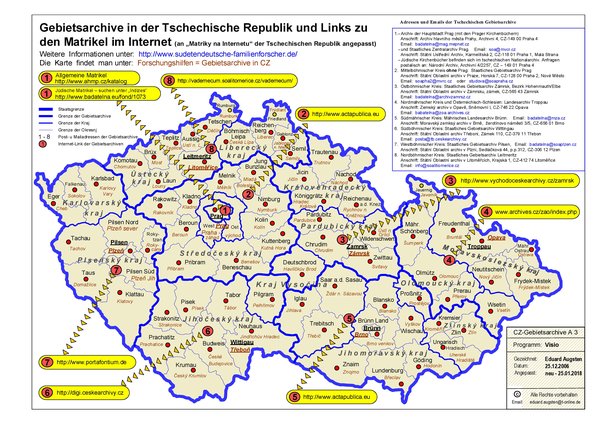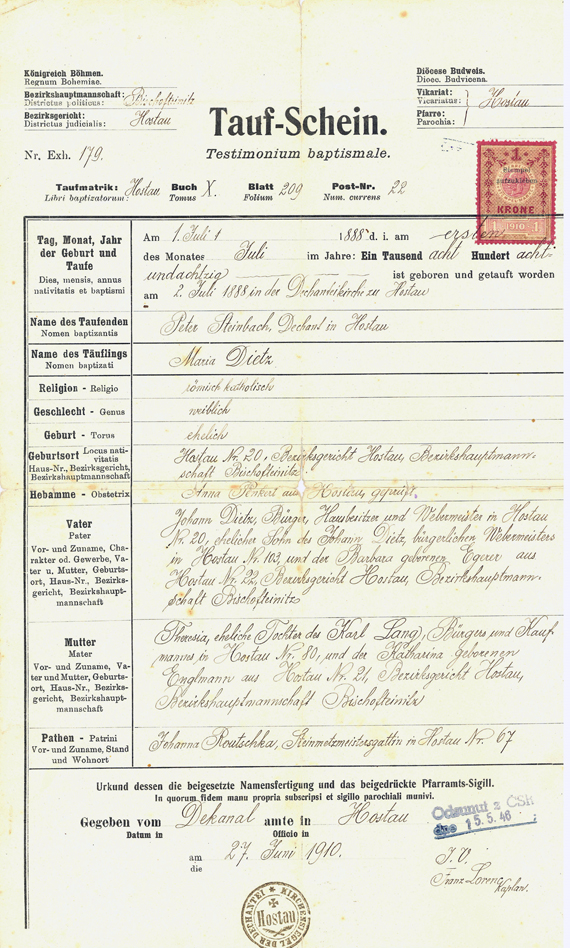Genealogy
Who once starts to deal with genealogy, has to take into consideration, that he will never be able to come to an end. Commitment, sense of family, understanding, patience and a common sense of community are absolutely necessary to address oneself with this topic. Genealogy creates an addiction, costs money, takes much time and the rest of the whole clan is very pleased that a "stupid one" commits himself to do all the work. However, it is an enormous pleasure to see how the collected information fits together as a whole, which seems to be arranged by single mosaic pieces. "Immersing" into the past enables impressions of the ancestors' life. Furthermore, it offers a variety of completely new impressions and a bigger understanding for the phylogeny of the own the family. The starting point can be completely private to fulfill the need to investigate the roots of their own origin. In addition, this implies at the same time the historical and political dimension of genealogy. Now after over 55 years the need is unbroken to gain details about one’s Sudeten-German ancestors. Furthermore, for many younger people, genealogy becomes a passion, which overrides the still existing doubts of the expelled generation. After the resettlement these people had to install a new economy. Additionally the discussion on the tragedy of the expulsion got more and more into the background. Many of the expelled ones thought it might be better not to tell everybody where they originated. In the meantime, people went back to a successful life. Therefore, no one was interested, that the others would know about their ancestors who had been perhaps poor cottagers, daytallers, sheppards or agricultural laborers. Anyway the quotation of Kleo Player characterizes best the identity of the Sudeten-Germans: "The colonization of the Sudeten-area is an era of heroism in the Sudeten-German history. In the ancestral portrait gallery of the Sudeten-Germans there are only a few men with a shining armor and uniform, however, there are millions of furrowed faces, and millions of callous hands. They seem to be poor ancestors. Yet a shining had derived form these faces and hands for centuries, and this shining was called the luminescent brilliance of the Bohemian crown.”
The reciprocal cohabitation of Czechs and German was and still is influenced by many historical incidents and their perplexities. As a consequence of these mutual histories, there was a large and disruptive division of many invaluable records which are stored today separately in different Czech and Bavarian archives. The Regional Archives in Pilsen and the head office of the State Archives of Bavaria in Munich implemented a joint transborder project to put all the divided records together again on a virtual level. By means of a widespread digitalization, there could be the potential of a common web site and a virtual reconstruction on the internet.
On the one hand in the Czech Archives, there a large quantity of records is stored with a direct reference to the Sudeten-German history and the Bavarian borderland. On the other side, the Bavarian Main State Archives took over records of the Sudeten-German Archives in Munich. There are many records with an immediate acquisition to today’s territory of the Czech Republic. Most records of the Sudeten-German Archives were carried over on foot during the expulsion by the Sudeten-German population. These records consist of the provenance of communal archives, pictures, noble and ecclesiastical archives, chronicles of cities, parishes and schools and other records with a local or regional reference. By the realization of the project, “Bavarian-Czech Network of digital historical Records” associated records were put together after 65 years since the WWII on a virtual basis. Digital reproductions were developed which could be presented by means of a webserver to a larger public, scientists and regional historians. The intention is that a cooperation of archivist, historians and other qualified persons will be achieved to discover and work on unknown and not yet published records in archives of both countries, the so-called Bohemics and Sudetics. The realization of this project will be an essential contribution to a better relationship between Czechs and Germans. Furthermore, it will be an exemplary stage for professional communication between the archives, the historic workplaces and further functional and academic institutions.
By the turn of the year 2013/2014, the release of all digitized church records of the Regional Archives in Pilsen was completed and put on the joint web -site Porta Fontium. All so far electronically registered church records and other historical documents (e.g. birth records of Hostau from 1598 to 1938) can be found on the internet at http://www.portafontium.de. There is a menu item called “Recherche”. A town or village can simply be searched by its German or Czech place name: Hostau accordingly „Hostouň“.
All records of the parish in Hostau are stored at the state-run regional archives in Pilsen:
Státní oblastní archiv v Plzni
Sedlackova 44
CZ-306 12 Plzen (Czech Republic)
Tel. +420-377 236 263, 377 325 732
Fax: 377 327 269
Email: podatelna@soaplzen.cz
Volume|Film|Records |Place |years from/to
- 1 SM602 *i oo + Tschernahora, Zwirschen, 1633-1716
Holubschen, Mirkowitz,
Hostau, Alt-Gramatin - 2 SM603 * oo + Pfarrsprengel 1686-1741
- 3 SM604 *i oo + Holubschen, Mirkowitz, 1737-1758
Hostau, Alt-Gramatin - 4 SM605 *i oo i + Holubschen, Mirkowitz, 1759-1828
Hostau, Alt-Gramatin - 5 *i Horouschen 1784-1843
- 6 *i Mirkowitz 1784-1838
- 7* i Zwirschen 1784-1834
- 8 oo Hostau, Mirkowitz, 1784-1827
Zwirschen, Horouschen - 9 SM606 * oo + Tschernahora, Zwirschen, 1775-1784
Alt-Gramatin, Hostau,
Mirkowitz, Holubschen - 10 SM606A * Tschernahora, Zwirschen, 1784-1831
Hostau, Mirkowitz - 11 * Hostau 1801-1815
- 12 * Hostau 1815-1836
- 13 *i Hostau 1836-1860
- 14 ooi Hostau 1827-1883
- 15 +i Horouschen 1784-1886
- 16 + Hostau, Tschernahora, 1784-1807
Zwirschen - 17 + Hostau 1808-1833
- 18 +i Hostau 1833-1868
- 19 Index * oo + Pfarrsprengel 1686-1837
- 20 *i Hostau 1861-1888
- 21 *i Horouschen 1844-1885
- 22 *i Zwirschen 1834-1892
- 23 ooi Horouschen 1784-1910
- 24 ooi Mirkowitz 1784-1931
- 25 ooi Zwirschen 1784-1931
- 26 +i Hostau 1869-1900
- 27 +i Mirkowitz 1784-1892
- 28 +i Zwirschen 1784-1897
Comments:
Horouschen and Alt-Gramatin belonged to the parish of Muttersdorf till 1784; Holubschen was part of the parish in Melmitz after 1784.
Place names in German and Czech language:
- Hostau = Hostouň
- Horouschen = Horoušany
- Zwirschen = Svržno
- Alt-Gramatin = Starý Kramolín
- Mirkowitz = Mirkovice
- Holubschen = Holubec
- Tschernahora = Cernahora
For further information read the GBHS newsletters:

